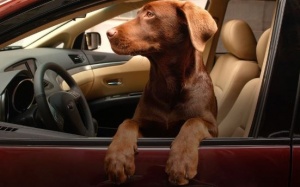How to Protect Your Pets and Your Car Passengers from the Heat
While the June heatwave has broken several records in Spain, the country’s media are sharing tips on how to protect yourself from the heat and stay healthy. Thinkspain provides information on how to stay safe during a car trip in the hottest weather, as well as how to protect your pets from the heat.
In Spain, even the oldest cars are usually equipped with air conditioning, as in some regions of the country the temperature in June reaches more than 40 degrees. Therefore, before a summer trip, it is necessary to make sure that the air conditioning system is in good working order. At the same time, drivers and passengers should not direct cold air directly to the face or body to avoid catching a cold. Before starting to drive, the air conditioner should be turned on at full power in circulation mode so that the cooling is distributed throughout the cabin as quickly as possible. At the same time, it is recommended to open the windows for fresh air. When the temperature in the cabin drops, you can reduce the power of the air conditioner and close the windows.
When parking, the car windows should be covered with a special screen to protect the interior from sunlight. You can also cover the rear windows. It is useful to use protective covers for the steering wheel, which are put on during parking. If possible from a safety point of view, the windows can be slightly opened to allow air circulation. If the seats and dashboard are dark, it is better to cover them, as dark materials absorb heat and turn the interior into a sauna. Before getting into the car, it is necessary to check the temperature of the child car seat. Children, elderly people and animals should not enter the cooled interior of the car to avoid discomfort.
It is important to take enough water for yourself and the car, and make sure your mobile phone is working. It is useful to have a large umbrella and a cooler in case of unexpected breakdowns in a remote location.
How to Protect Pets from the Heat
The main advice from the specialists of the Madrid Veterinary College is to closely monitor the behavior of your pets. Few people know that dogs and cats can suffer from heat stroke, just like people. Animals do not sweat, and therefore their body temperature does not drop as quickly as in humans. Those most susceptible to breathing problems in hot weather are breeds of dogs and cats with flattened noses, overweight animals, as well as puppies, kittens and older animals, which require special attention on hot days.
Leaving pets in a parked car is strictly prohibited, as just a few minutes in a hot car interior is enough for the animal to die from heatstroke. The Spanish National Guard reminds owners of the “five-second rule”: cats and dogs can burn their paws on hot asphalt. To check the temperature of the asphalt, just put your hand on it: if your hand does not last more than five seconds, the animal should not be released.
The main symptoms of heat stroke in dogs and cats are: trembling or sudden movements, difficulty breathing, increased salivation, nosebleeds, vomiting, increased heart rate, and cessation of movement. In this case, it is necessary to immediately move the animal to a cool place protected from the sun, give it water to drink, and wash the body with water at room temperature. You should also contact a veterinarian.
If the animal spends most of its time in the yard, it should be allowed indoors more often and even the litter tray should be moved there. The animal should always have free access to clean, fresh water. If there is a cat in the house, the rooms should be constantly ventilated. Animals that shed heavily may have problems in the summer. Therefore, it is worth preferring special food and regularly combing their fur. In hot months, it is better to feed animals dry food. If this is not possible, the remains of wet food should be removed immediately after feeding.
